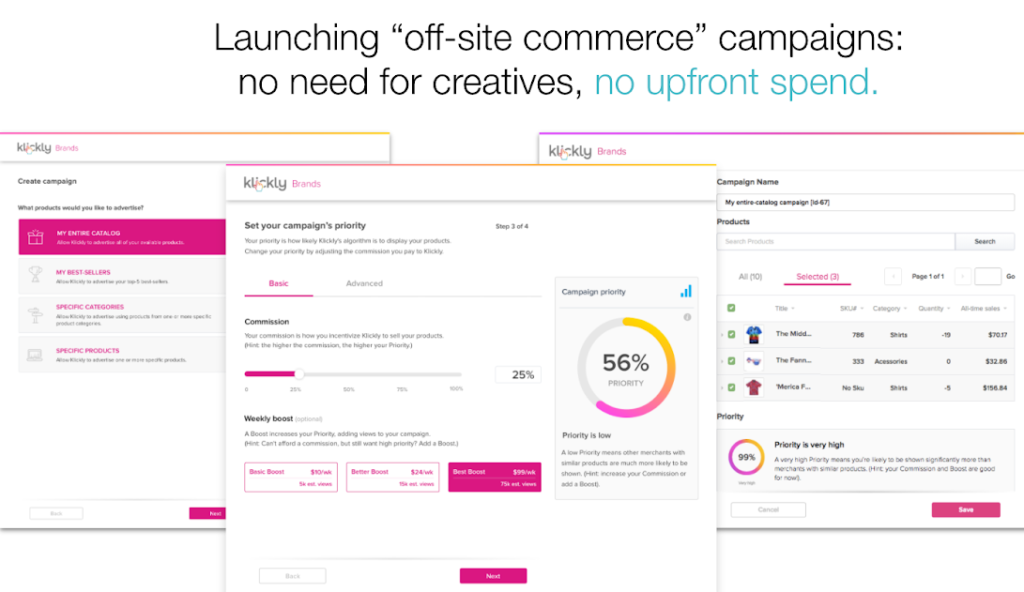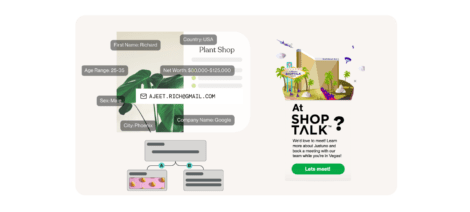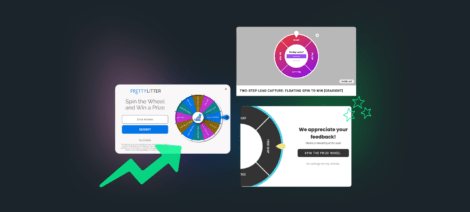Everybody loves the possible benefits of advertising but not the high cost and lack of guaranteed outcomes associated with it. Today’s giants — whether that’s Facebook, AdRoll, or elsewhere— have established a standard advertising pricing model. No matter who you choose, it’s the same: put money in, gather impressions, clicks, and engagement…then hope they turn into sales.
Most marketers have become complacent with this model, because it’s been the standard for so long –– at our company, Klickly, we see a ton of good marketers with the same issue: you’re resigned that there is rarely a guarantee for actual revenue (or even good performance), let alone assurance that your return on ad spend (ROAS) will pay off. You’ve settled for spending money ‘upfront,’ hoping the ads will get sales.
The top complaints we hear every day about advertising are:
- We wasted a ton of money on advertising, got a bunch of clicks, but only a few sales.
- Ads worked great, but my CPC is through the roof!
- My ads get people to my site, but the drop-off rate is crazy high!
After listening to these complaints for over a year, we at Klickly set out on the giant task of creating an advertising platform that addressed ALL of these issues. So, obviously we may be slightly biased, but we wanted to tell you about why we think it’s so important to demand accountable advertising and how to make sure you get the most out of your ad spend.
(If you’re feeling generous, we’d also love to get your take on the platform we built, check it out here.)

In our opinion, if you’re using an advertising platform that makes you pay “upfront” for advertising––with no performance guarantees––you should stop! These standard platforms won’t work as hard for your sales; they already have your money. This money could’ve been spent more efficiently elsewhere…or gone toward your yacht fund ;).
If you’ve been paying out on the traditional models above (we don’t blame you, everyone does it), take a look at the three ways you can take back control of your ads:
- Only pay for ads that are performance-based (i.e. only pay when ads actually drive sales)
- Find an advertising platform that can guarantee or “lock-in” your ROAS
- Make your ad creative as efficient as possible
1. True performance-based advertising (hint: it’s not CPC)
The most common form of this payment model is affiliate marketing. Affiliate sites have their upsides for a few reasons:
- They can increase your revenue with little to no work
- They can moderately increase your sales within days of going live
- They have easy access to very specific niches
However, affiliate marketing has a natural limit: once affiliates reach their core audience, it’s difficult to expand from there. That’s because affiliates do not actively advertise your products to consumers who are the best-match across millions of sites; they’re simply showing your products on one site.
We believe an advertising platform should have all the qualities of the performance-based model brands love –– you only pay when we drive sales –– BUT while actively advertising your products on unlimited sites (think ESPN, Vogue, Instyle, etc). And that’s what we’ve aimed to do with Klickly –– as a smart marketer you can grow your brand’s audience in a risk-free way, and pay only when you drive sales.
2. Demand some sort of guarantee on your ROAS
This is arguably the trickiest part of advertising. As stated earlier, when you’re paying on CPM, CPC, etc., you won’t have guarantees on what returns or revenue you’ll get in return.
Traditionally, the only folks who can help you advertise for guaranteed results are performance marketing agencies. These are agencies that operate your campaigns and are sometimes paid based on a percentage of sales they drive.
These agencies typically only accept a few fast-trending brands (usually selling a single niche product with a high profit margin) due to the amount of risk they take on. They also usually require brands to agree to stringent, locked-in terms, without the ability to easily renegotiate changes. You may be required to work with the agency for six to twelve months and split the revenues at a set rate of 30% or higher.
After studying this model, we essentially tried to build Klickly around the good parts of a performance marketing agency, but with a key difference. Klickly lets you choose your terms and lock-in your returns. You can also A/B test different commission settings by running multiple campaigns at no extra charge.
We’ve started to see that, since you have full control over your commission, smart marketers will use it to lock in your ROAS, like the examples below:
- If you want a guaranteed 3x ROAS (or a 3:1 return), set a 33% commission
- If you want a guaranteed 5x ROAS (or a 5:1 return), set a 20% commission
3. Use efficient, cutting-edge ads
Creating effective ads that accurately showcase your products while also capturing consumers’ attention is very difficult. People today have become relatively banner blind to word-heavy advertisements and we’re constantly bombarded with promotions everywhere we look.
Even if consumers click on an ad, trying to navigate to the website (often using a mobile device) to actually make the purchase is a pain-in-the-you-know-what.
We wanted to take a radically different approach to ad creative. So we created the first-ever buyable ads, where consumers can buy your products directly within the ads.
This lets the consumer purchase on the spot, without ever leaving the page they’re browsing on. Now, your ads are basically functioning as millions of “mini-sites” around the web, and customers can purchase faster and easier than ever before.
An interesting shopping fact, $5 trillion (yes, with a “T” ;) of goods were abandoned in shopping carts in 2017 (eMarketer, Dec 2017). With Klickly ads, consumers don’t have the chance to abandon their cart, since they can complete an impulse purchase directly in the ad.

Conclusion
There are more online consumers today than ever before (AKA a huge opportunity)! Unfortunately, we feel like a number of advertising options don’t seem to be on the brands’ side; platforms aren’t beholden to actually deliver anything to those doing the ad buying. Using technology (some machine-learning and cool buyable ads), we’re trying to change this –– by asking the hard questions and giving suggestions, we’re hoping to change how brands think about buying advertising.
Keep the three tips above in mind when planning and buying your future advertising. And if you ever do want to try a platform working really hard to innovate on the old traditional models in the industry … it takes five minutes, no upfront spend to set up, and we’d love to hear your thoughts on Klickly.
If you’re a Justuno user, fill out this online form to get some special perks such as access to our invite-only platform + and a “skip the line” link, two weeks of free “Campaign Boost” (guaranteed 30K impressions), and premium-tier account management services for one month.


